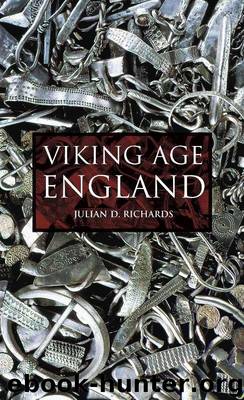Viking Age England by Julian D Richards

Author:Julian D Richards
Language: eng
Format: mobi, epub
ISBN: 9780750952521
Publisher: The History Press
Published: 2013-06-27T16:00:00+00:00
ANIMALS
It is unlikely that the Vikings had much effect upon animal husbandry. There is nothing particularly Scandinavian about the bone assemblage at Coppergate, for example, and nothing to suggest the introduction of Scandinavian stock. Nevertheless, there were developments in animal husbandry during the Viking Age in response to general economic trends, and changes, in particular, in the relative importance of various farm animals (Clutton-Brock 1976).
Cattle
Cattle bones are predominant on all Viking Age sites, within and outside the Danelaw, and beef and dairy products would have been the dietary mainstays throughout England. A particularly high proportion of cattle bones has been observed in excavated Viking settlements, namely York, Dublin and Lincoln. We know that the keeping of cattle was culturally important to Viking settlers, and immigrants in Greenland and Iceland stubbornly hung on to their cattle herds, despite the climatic and environmental difficulties. Nevertheless, variations in stock-breeding strategies in England are more likely to have been dictated by local agricultural and economic circumstances than by ethnic affiliations.
Cattle provided most meat in the diet at sites as far apart as Mawgan Porth, Portchester, Cheddar, North Elmham and York. At Flaxengate it has been calculated that cattle provided over 75 per cent of the meat diet. At Coppergate cattle appear to have been brought in on the hoof as required and slaughtered on site, whereas in Durham and Cheddar meat was obtained ready-butchered.
In York the cattle were killed by a blow to the head and butchered in a clumsy and unsystematic fashion which is inconsistent with specialist butchers, in contrast to the Roman period. Evidence from Lincoln suggests that the carcasses were butchered on the floor; they were only hung from timber beams from the eleventh century onwards. There was no careful selection of cattle of a particular age; most were youngish adults, suggesting that cattle had a multipurpose role as milk producers and draught animals as well as sources of meat. On rural sites oxen would also have been important for pulling the heavy plough.
Download
This site does not store any files on its server. We only index and link to content provided by other sites. Please contact the content providers to delete copyright contents if any and email us, we'll remove relevant links or contents immediately.
| General | Channel Islands |
| England | Northern Ireland |
| Scotland | Wales |
Room 212 by Kate Stewart(4716)
The Crown by Robert Lacey(4555)
Endurance: Shackleton's Incredible Voyage by Alfred Lansing(4474)
The Iron Duke by The Iron Duke(4098)
The Rape of Nanking by Iris Chang(4003)
Killing England by Bill O'Reilly(3889)
Joan of Arc by Mary Gordon(3766)
Say Nothing by Patrick Radden Keefe(3695)
I'll Give You the Sun by Jandy Nelson(3248)
Shadow of Night by Deborah Harkness(3160)
Hitler's Monsters by Eric Kurlander(3142)
Blood and Sand by Alex Von Tunzelmann(3040)
Mary, Queen of Scots, and the Murder of Lord Darnley by Alison Weir(3033)
Darkest Hour by Anthony McCarten(3007)
Margaret Thatcher: The Autobiography by Thatcher Margaret(2962)
Eleanor & Park by Rainbow Rowell(2926)
Red Famine: Stalin's War on Ukraine by Anne Applebaum(2804)
Book of Life by Deborah Harkness(2704)
The One Memory of Flora Banks by Emily Barr(2673)
